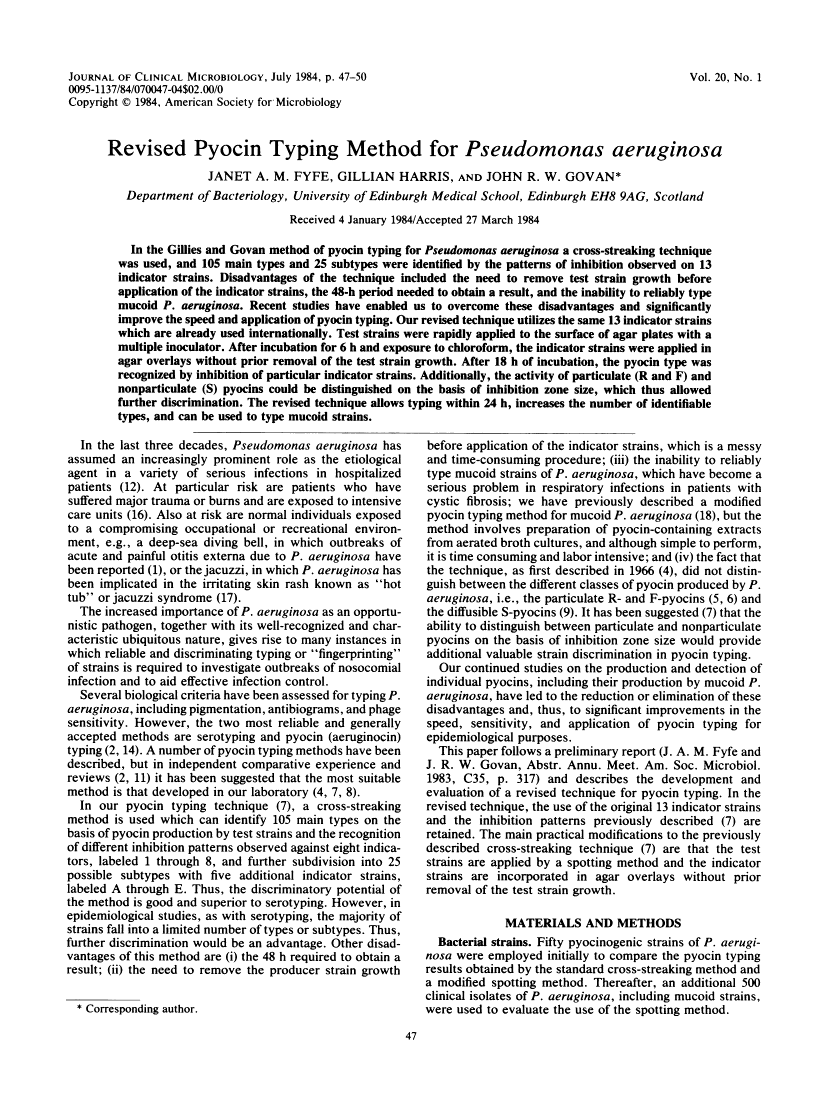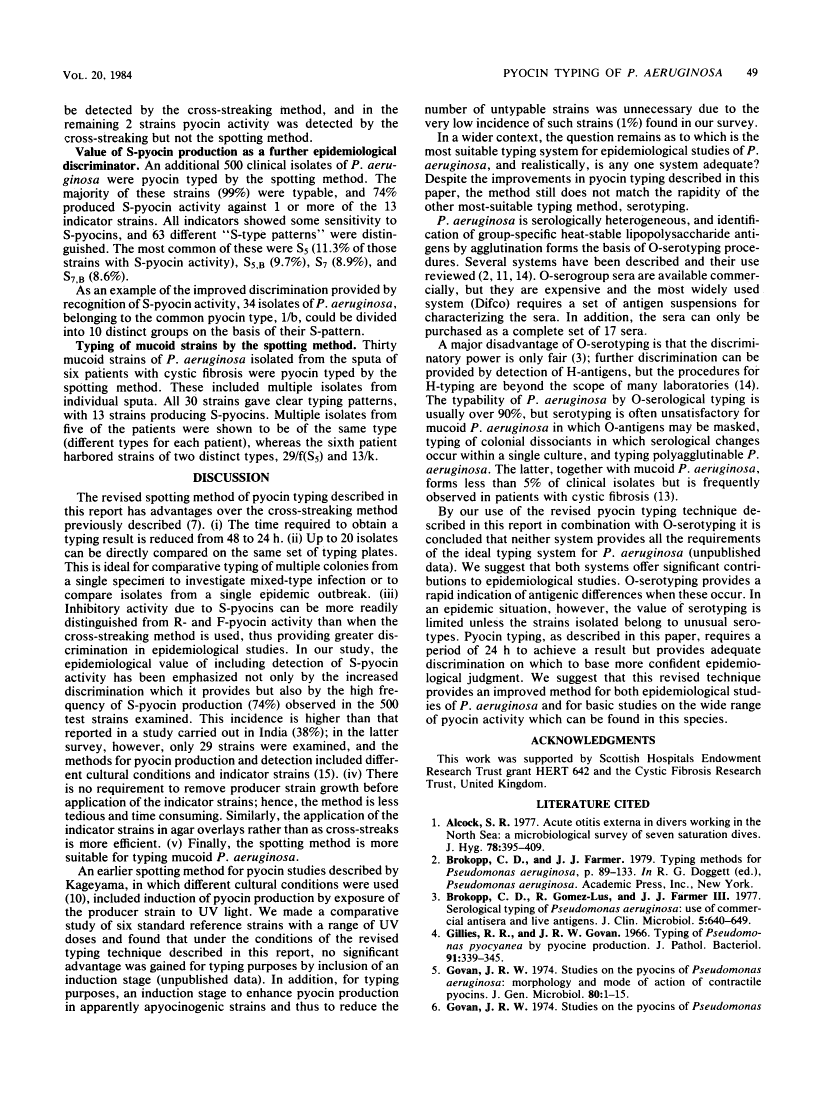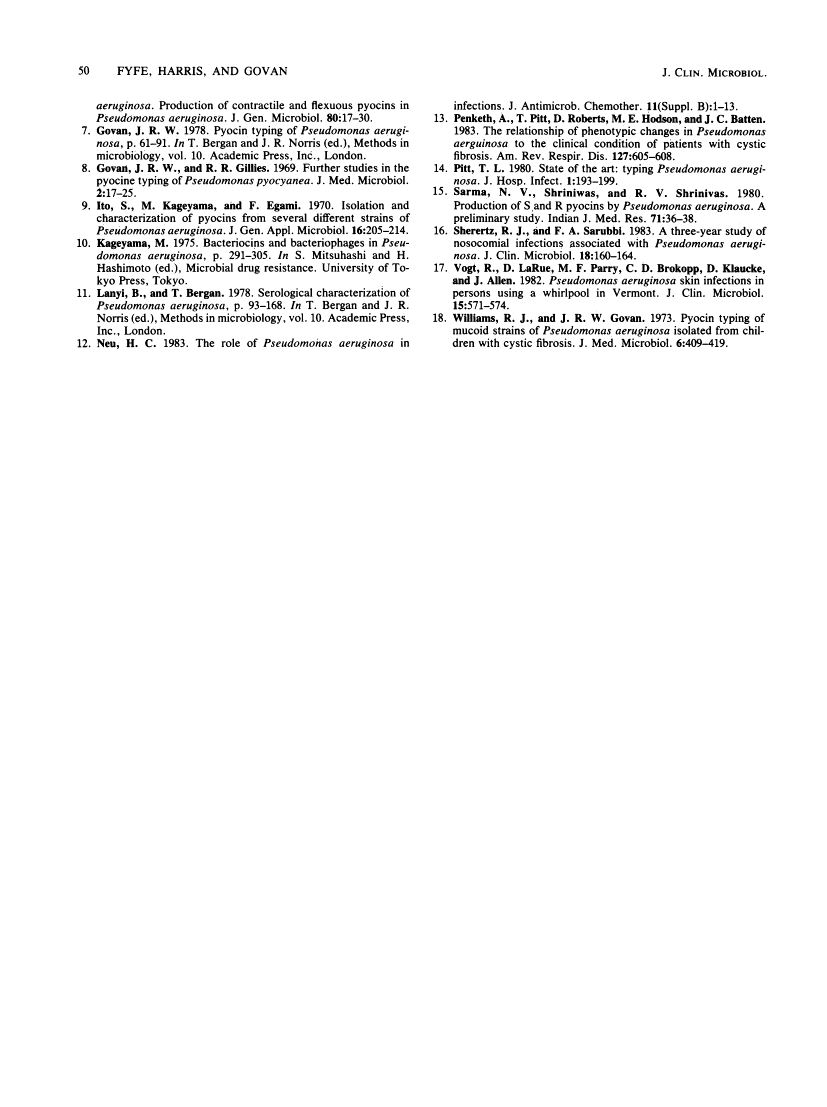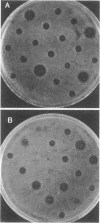Abstract
Free full text

Revised pyocin typing method for Pseudomonas aeruginosa.
Abstract
In the Gillies and Govan method of pyocin typing for Pseudomonas aeruginosa a cross-streaking technique was used, and 105 main types and 25 subtypes were identified by the patterns of inhibition observed on 13 indicator strains. Disadvantages of the technique included the need to remove test strain growth before application of the indicator strains, the 48-h period needed to obtain a result, and the inability to reliably type mucoid P. aeruginosa. Recent studies have enabled us to overcome these disadvantages and significantly improve the speed and application of pyocin typing. Our revised technique utilizes the same 13 indicator strains which are already used internationally. Test strains were rapidly applied to the surface of agar plates with a multiple inoculator. After incubation for 6 h and exposure to chloroform, the indicator strains were applied in agar overlays without prior removal of the test strain growth. After 18 h of incubation, the pyocin type was recognized by inhibition of particular indicator strains. Additionally, the activity of particulate (R and F) and nonparticulate (S) pyocins could be distinguished on the basis of inhibition zone size, which thus allowed further discrimination. The revised technique allows typing within 24 h, increases the number of identifiable types, and can be used to type mucoid strains.
Full text
Full text is available as a scanned copy of the original print version. Get a printable copy (PDF file) of the complete article (940K), or click on a page image below to browse page by page. Links to PubMed are also available for Selected References.
Images in this article
Selected References
These references are in PubMed. This may not be the complete list of references from this article.
- Alcock SR. Acute otitis externa in divers working in the North Sea: a microbiological survey of seven saturation dives. J Hyg (Lond) 1977 Jun;78(3):395–409. [Europe PMC free article] [Abstract] [Google Scholar]
- Brokopp CD, Gomez-Lus R, Farmer JJ., 3rd Serological typing of Pseudomonas aeruginosa: use of commercial antisera and live antigens. J Clin Microbiol. 1977 Jun;5(6):640–649. [Europe PMC free article] [Abstract] [Google Scholar]
- Gillies RR, Govan JR. Typing of Pseudomonas pyocyanea by pyocine production. J Pathol Bacteriol. 1966 Apr;91(2):339–345. [Abstract] [Google Scholar]
- Govan JR. Studies on the pyocins of Pseudomonas aeruginosa: morphology and mode of action of contractile pyocins. J Gen Microbiol. 1974 Jan;80(1):1–15. [Abstract] [Google Scholar]
- Govan JR, Gillies RR. Further studies in the pyocine typing of Pseudomonas pyocyanea. J Med Microbiol. 1969 Feb;2(1):17–25. [Abstract] [Google Scholar]
- Neu HC. The role of Pseudomonas aeruginosa in infections. J Antimicrob Chemother. 1983 May;11 (Suppl B):1–13. [Abstract] [Google Scholar]
- Penketh A, Pitt T, Roberts D, Hodson ME, Batten JC. The relationship of phenotype changes in Pseudomonas aeruginosa to the clinical condition of patients with cystic fibrosis. Am Rev Respir Dis. 1983 May;127(5):605–608. [Abstract] [Google Scholar]
- Pitt TL. State of the art: typing Pseudomonas aeruginosa. J Hosp Infect. 1980 Sep;1(3):193–199. [Abstract] [Google Scholar]
- Sarma NV, Shriniwas, Srinivas RV. Production of S and R pyocins by Pseudomonas aeruginosa--a preliminary study. Indian J Med Res. 1980 Jan;71:36–38. [Abstract] [Google Scholar]
- Sherertz RJ, Sarubbi FA. A three-year study of nosocomial infections associated with Pseudomonas aeruginosa. J Clin Microbiol. 1983 Jul;18(1):160–164. [Europe PMC free article] [Abstract] [Google Scholar]
- Vogt R, LaRue D, Parry MF, Brokopp CD, Klaucke D, Allen J. Pseudomonas aeruginosa skin infections in persons using a whirlpool in Vermont. J Clin Microbiol. 1982 Apr;15(4):571–574. [Europe PMC free article] [Abstract] [Google Scholar]
- Williams RJ, Govan JR. Pyocine typing of mucoid strains of Pseudomonas aeruginosa isolated from children with cystic fibrosis. J Med Microbiol. 1973 Aug;6(3):409–412. [Abstract] [Google Scholar]
Associated Data
Articles from Journal of Clinical Microbiology are provided here courtesy of American Society for Microbiology (ASM)
Full text links
Read article at publisher's site: https://doi.org/10.1128/jcm.20.1.47-50.1984
Read article for free, from open access legal sources, via Unpaywall:
https://jcm.asm.org/content/jcm/20/1/47.full.pdf
Free to read at intl-jcm.asm.org
http://intl-jcm.asm.org/cgi/content/abstract/20/1/47
Free after 4 months at intl-jcm.asm.org
http://intl-jcm.asm.org/cgi/reprint/20/1/47.pdf
Citations & impact
Impact metrics
Article citations
Mucin adhesion of serial cystic fibrosis airways Pseudomonas aeruginosa isolates.
Front Cell Infect Microbiol, 14:1448104, 22 Aug 2024
Cited by: 0 articles | PMID: 39239637 | PMCID: PMC11374773
Evolutionary and ecological role of extracellular contractile injection systems: from threat to weapon.
Front Microbiol, 14:1264877, 11 Oct 2023
Cited by: 5 articles | PMID: 37886057 | PMCID: PMC10598620
Review Free full text in Europe PMC
Study of 32 new phage tail-like bacteriocins (pyocins) from a clinical collection of Pseudomonas aeruginosa and of their potential use as typing markers and antimicrobial agents.
Sci Rep, 13(1):117, 03 Jan 2023
Cited by: 6 articles | PMID: 36596850 | PMCID: PMC9810705
Diguanylate Cyclase (DGC) Implicated in the Synthesis of Multiple Bacteriocins via the Flagellar-Type III Secretion System Produced by Pectobacterium carotovorum subsp. carotovorum.
Int J Mol Sci, 23(10):5649, 18 May 2022
Cited by: 0 articles | PMID: 35628457 | PMCID: PMC9144310
Unraveling the Uncharacterized Domain of Carocin S2: A Ribonuclease Pectobacterium carotovorum subsp. carotovorum Bacteriocin.
Microorganisms, 10(2):359, 04 Feb 2022
Cited by: 1 article | PMID: 35208813 | PMCID: PMC8878655
Go to all (86) article citations
Similar Articles
To arrive at the top five similar articles we use a word-weighted algorithm to compare words from the Title and Abstract of each citation.
[Pyocin typing of 111 strains of Pseudomonas aeruginosa isolated in Tuscany, using the Gillies and Govan method].
Ann Sclavo, 20(4):616-624, 01 Jul 1978
Cited by: 0 articles | PMID: 111627
[Pyocin production by bacillus pyocyaneus and sensitivity of strains of different origin to them].
Zh Mikrobiol Epidemiol Immunobiol, (7):8-13, 01 Jul 1980
Cited by: 0 articles | PMID: 6776722
A Pseudomonas pyocin typing method applicable to the clinical laboratory.
Am J Med Technol, 45(8):688-691, 01 Aug 1979
Cited by: 0 articles | PMID: 114048
Epidemiological typing of Pseudomonas aeruginosa.
Eur J Clin Microbiol Infect Dis, 7(2):238-247, 01 Apr 1988
Cited by: 51 articles | PMID: 2455640
Review











